Natural Clogged Toilet Remedies: Vinegar & Baking Soda
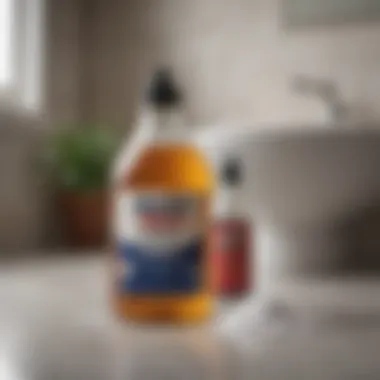
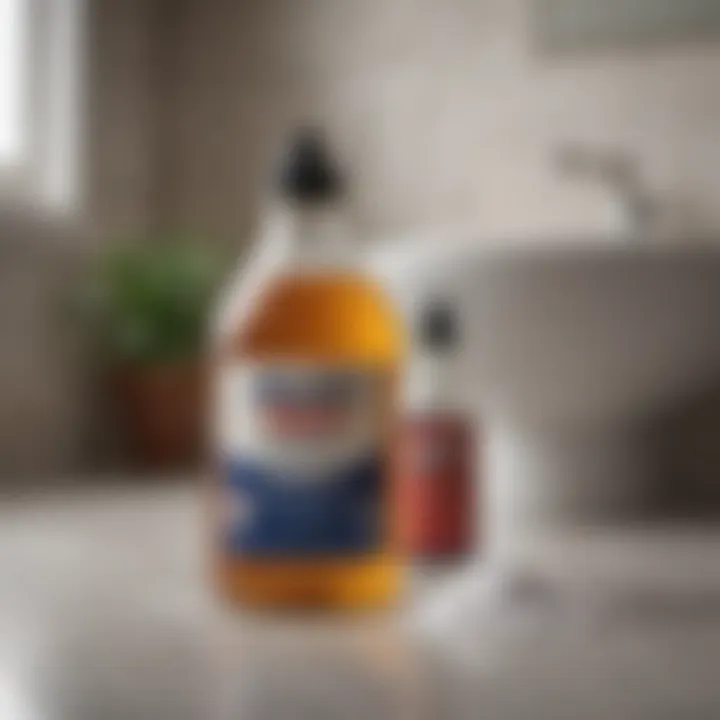
Intro
Clogged toilets can be a significant inconvenience for homeowners. They disrupt daily routines and can lead to unpleasant situations. Among various methods to address this issue, vinegar and baking soda stand out. These common household items offer a natural and environmentally friendly approach to unclogging toilets. Their effectiveness stems from their chemical properties. This article will provide a deep dive into how these substances can be employed effectively for your plumbing challenges.
Design Inspiration
While the primary focus is on practical solutions, design inspiration plays a role in maintaining a well-functioning bathroom. A thoughtfully designed restroom can enhance the overall experience of tackling maintenance issues.
Trending Styles
When thinking about bathroom design, modern minimalism and classic elegance often come to mind. Clean lines and uncluttered spaces are popular. Incorporating eco-friendly materials that resonate with sustainable practices reflects both style and concern for environmental impact. Choosing fixtures that allow for easy maintenance aligns with the practical use of vinegar and baking soda in unclogging toilets.
Color Palettes
Color choice can influence the mood in a bathroom. Soft, neutral colors create a calm environment, while brighter hues can add energy. When planning a renovation or redesign, it is vital to consider the ease of cleaning and maintenance. Choosing tiles and surfaces that complement vinegar and baking soda's cleaning properties ensures that your bathroom remains both beautiful and functional.
Practical Tips
Practical tips focus on embracing effective methods for toilet maintenance, ensuring longevity while incorporating elements of design. Utilizing vinegar and baking soda in regular practices can prevent major issues over time.
Maintenance & Care
Toilet maintenance can often be simplified with routine practices. Using vinegar and baking soda regularly can help maintain plumbing, prevent clogs, and reduce mineral build-up. Here’s how:
- Monthly Clean: Pour one cup of baking soda followed by one cup of vinegar into the toilet. Let it sit for 30 minutes, then flush. This routine helps in breaking down small clogs and freshening the toilet.
- Stain Removal: For hard water stains, let the vinegar soak for a few hours before scrubbing with a toilet brush.
- Odor Control: Regular use of these substances can help keep odors at bay without resorting to harsh chemicals.
Budgeting & Planning
Clogged toilets can lead to expensive repairs if not maintained properly. Budgeting for eco-friendly solutions can lead to cost savings in the long run. Using vinegar and baking soda not only saves money but also minimizes the need for commercial cleaners, which can be expensive. Here are a few tips to consider:
- Bulk Purchase: Buy vinegar and baking soda in bulk to save costs.
- DIY Solutions: Embrace DIY cleaning strategies to avoid high plumber fees.
- Routine Planning: Set reminders for regular maintenance to avoid sudden plumbing emergencies.
Important Note: Regularly engaging in maintenance routines can prevent the need for costly repairs down the line.
By integrating vinegar and baking soda into both cleaning routines and the overall maintenance strategy, homeowners can enhance their bathroom experience while taking a sustainable approach to home care. These practices ensure your toilet remains functional and reduce the risk of unexpected clogs.
Prolusion to Clogged Toilets
Clogged toilets are a common household issue that can create significant inconvenience. Understanding the causes and signs of toilet clogs is essential for effective solutions. Often, these situations arise unexpectedly, leading to frustration. Identifying the underlying issues can aid homeowners in resolving them swiftly and effectively.
Common Causes of Toilet Clogs
Toilets can become clogged for various reasons. Some of the most prevalent causes include:
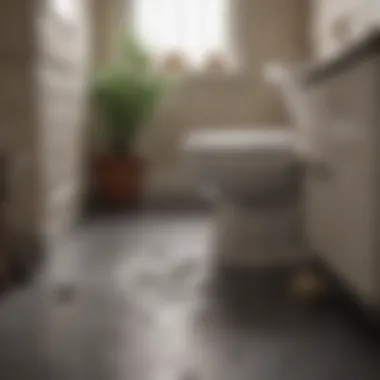
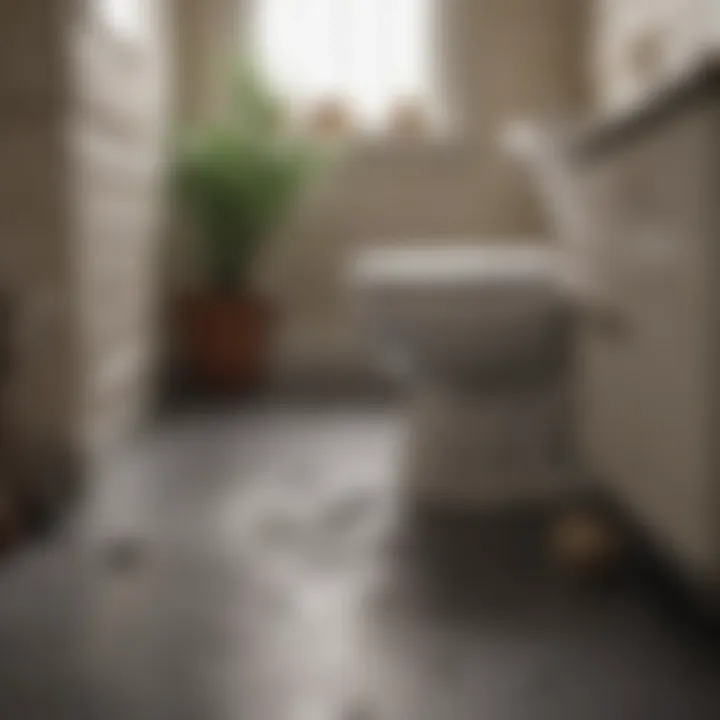
- Excessive Toilet Paper Use: Many people underestimate the amount of toilet paper that can cause a clog. Using too much can lead to blockages, especially in older plumbing systems.
- Foreign Objects: Items not intended for toilets frequently contribute to clogs. This might include children’s toys, sanitary products, or even toilet cleaning tablets that dissolve poorly.
- Flushing Non-Flushables: Some individuals mistakenly flush items labeled as flushable. These products may not break down properly, leading to clogs over time.
- Tree Roots: In older homes, tree roots can invade sewer lines, causing blockages that affect toilet drainage, often unnoticed until significant buildup occurs.
- Hard Water Build-Up: Over time, minerals from hard water can accumulate in pipes, narrowing them and making clogs more likely.
Awareness of these causes allows homeowners to take preventive measures before clogs develop, ensuring smoother plumbing operations.
Signs of a Clogged Toilet
Recognizing the signs of a clogged toilet is crucial for timely action. Early intervention can save homeowners from bigger problems. Typical indicators include:
- Slow Drainage: If the toilet takes longer to drain after flushing, it could signal an impending clog.
- Gurgling Noises: Unusual sounds may emanate from the toilet or surrounding plumbing, often indicating a blockage somewhere in the system.
- Water Back-Up: If the water level rises unusually high after a flush or fills slowly, this can be a clear warning of a clog.
- Frequent Need for Plunging: If a toilet often needs to be plunged, it suggests that clogs are becoming a recurring issue.
Understanding these indicators can help homeowners act swiftly, potentially avoiding a full-blown plumbing emergency.
Understanding Vinegar and Baking Soda
Understanding vinegar and baking soda provides insight into their effectiveness as a natural remedy for clogged toilets. Both substances are common household items with powerful properties that can address minor plumbing issues without the use of harsh chemicals. Their environmental impact is another significant factor. Homeowners who seek sustainable solutions can benefit from leveraging these everyday materials for cleaning and maintenance.
Chemical Properties of Vinegar
Vinegar, typically comprising acetic acid and water, has a pH level of around 2 to 3. This acidic nature allows it to dissolve mineral deposits, break down grease, and neutralize odors. Commonly used vinegar types, such as white and apple cider vinegar, provide similar benefits due to their acidity. The natural properties of vinegar make it an excellent choice for unclogging toilets. Its ability to react with organic matter and other debris can effectively aid in clearing blockages.
The Role of Baking Soda in Cleaning
Baking soda, chemically known as sodium bicarbonate, has a pH of approximately 9. When combined with vinegar, it becomes an effective cleaning agent. Baking soda can absorb moisture and odors, which ensures the bathroom stays fresher for longer periods. It also possesses mild abrasive properties that help scrub surfaces without scratching. This makes it useful not only for clogs but also for routine cleaning tasks, improving overall toilet hygiene.
Scientific Explanation of Chemical Reactions
The interaction between vinegar and baking soda presents a classic example of an acid-base reaction. When mixed, the acetic acid in vinegar reacts with sodium bicarbonate, producing carbon dioxide gas and water along with sodium acetate. This reaction creates bubbles that can help dislodge clogs, providing a physical force to move obstructions.
"The combination of vinegar and baking soda does not just act on organic matter; it generates gas that can push through a blockage, making it a dual-action treatment."
Additionally, this reaction is helpful in ensuring that the toilet bowl is cleaned while addressing the clog. This balance of effectiveness and safety in chemical reactions highlights why vinegar and baking soda are often recommended for minor plumbing problems.
Using Vinegar and Baking Soda for Clogs
Using vinegar and baking soda for clogs is essential to understand when exploring natural remedies for plumbing issues. Many homeowners seek effective solutions without resorting to harsh chemicals. Vinegar has acetic acid, which can break down solid waste and debris. Baking soda, on the other hand, is a mild abrasive and reacts with vinegar to create carbon dioxide bubbles. This reaction can help dislodge stubborn clogs while being environmentally friendly and non-toxic.
The benefits of these two substances are numerous. They not only unclog toilets but can also deodorize them and prevent future clogs. Additionally, using these natural substances eliminates the risk of harming plumbing systems unlike commercial chemical drain cleaners. There is also an element of cost-effectiveness because both vinegar and baking soda are affordable and commonly found household items.
It is important to consider the proper methods for using vinegar and baking soda effectively. Following correct procedures maximizes the chance of a successful unclogging. Attention to detail ensures that the chemical reactions are optimally utilized without unnecessary mess or complications.
Step-by-Step Instructions
- Prepare the Space: Begin by clearing the immediate area around the toilet to create a safe and accessible work space.
- Pour Baking Soda: Measure about one cup of baking soda and pour it directly into the toilet bowl. It is advisable to aim for the sides to distribute it evenly.
- Add Vinegar: Next, take one cup of white vinegar and pour it over the baking soda. Be ready, as the mixture will fizz and bubble.
- Wait: Allow the mixture to sit for at least 30 minutes. This waiting period helps the reaction to clear the clog effectively.
- Flush the Toilet: After 30 minutes, flush the toilet. Observe if the water drains properly. If clogs persist, consider repeating the process.
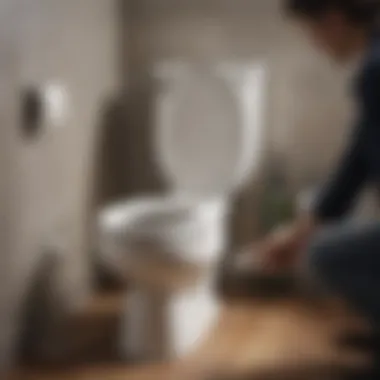
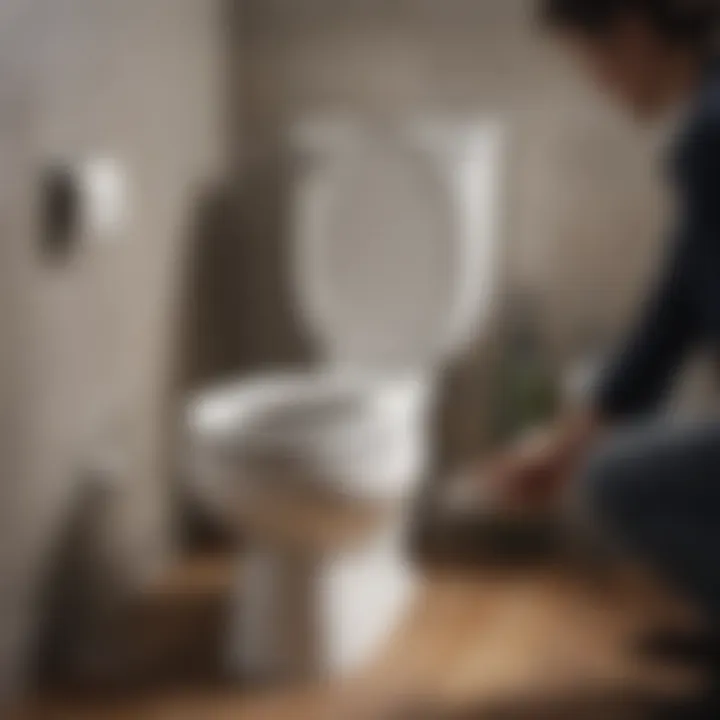
Required Materials and Tools
- White Vinegar: Essential for the chemical reaction with baking soda.
- Baking Soda: A pivotal component of this solution to aid in dislodging clogs.
- Measuring Cup: For accurate measurement of both vinegar and baking soda.
- Gloves: Optional, but recommended for cleanliness and to avoid any residue contact.
- Toilet Brush: Useful for any additional scrubbing needed after treatment.
Follow-Up Steps After Treatment
After administering the vinegar and baking soda treatment, it is important to follow up to ensure the long-term effectiveness of this method. Here are some recommended steps:
- Assess the Results: Check if the toilet is draining properly after the flush. If not, repeat the process or consider other methods.
- Regular Maintenance: To prevent future clogs, periodically use vinegar and baking soda as a preventive measure. This can be done once a month.
- Monitor Toilet Usage: Be aware of what goes into the toilet. Avoid flushing non-biodegradable items or excessive amounts of toilet paper.
Preventing Future Clogs
The importance of preventing future clogs cannot be overstated. Once a clog develops, it can lead to a multitude of issues, including unpleasant odors, slow drainage, and potential damage to plumbing systems. Employing strategies to prevent clogs not only ensures a more functional bathroom but also translates to cost savings in repairs and maintenance.
In this section, we will discuss both best practices for toilet use and regular maintenance tips to help homeowners and design enthusiasts alike maintain a clog-free toilet.
Best Practices for Toilet Use
Following appropriate practices while using the toilet is fundamental in preventing clogs. Some effective best practices include:
- Mindful flushing: Only flush human waste and toilet paper. Items like wet wipes, cotton balls, or hygiene products should be disposed of in a waste bin instead.
- Avoid excessive paper: Using large amounts of toilet paper can overwhelm the plumbing. Instead, use only what you need.
- Educate family members: Ensure everyone in your household understands the proper way to use the toilet. This includes not treating it as a trash can.
Implementing these practices can significantly reduce the frequency of clogs and ensure smoother operation of your toilet.
Regular Maintenance Tips
Regular maintenance is key to a functional toilet. By adopting a routine, you can significantly reduce the chance of a clog forming. Here are some effective maintenance tips:
- Routine cleaning: Clean your toilet regularly using natural cleaning solutions to prevent mineral buildup. Vinegar or baking soda can be effective for this task.
- Flushing system checks: Periodically inspect the flushing mechanism to ensure it operates properly. A weak flush can lead to incomplete waste removal.
- Water level adjustment: Check the water level in the toilet tank to ensure it is set correctly. A low water level can cause performance issues.
- Frequent inspections: Keep an eye out for signs of wear or blockage. Ensure that pipes are clear of debris to avoid unexpected clogs.
Alternative Methods for Clearing Clogs
Dealing with clogged toilets can be frustrating. While vinegar and baking soda offer natural solutions, it is beneficial to explore additional methods that homeowners can employ. Alternative methods for clearing clogs not only enhance problem-solving skills but also contribute to plumbing maintenance strategies. Adopting these techniques can prevent damage and promote long-term plumbing health.
Various tools and techniques exist, each with unique benefits. By diversifying approaches, one can effectively tackle toilet clogs. Knowing multiple methods ensures readiness when clogs occur. Here, two primary methods are highlighted: plunger techniques and commercial products.
Plunger Techniques
Plunging a clogged toilet can prove effective. The correct use of a plunger often determines success. Here's an outline of how to effectively use a plunger:
- Select the Right Plunger: Ensure you have a flanged plunger. It is designed specifically for toilets.
- Position the Plunger: Center the rubber part over the drain hole.
- Create a Seal: Ensure the plunger creates a tight seal around the drain. A proper seal maximizes pressure.
- Push and Pull: Firmly push down, then pull up without breaking the seal. Do this several times.
- Test the Toilet: After plunging, flush the toilet. Observe whether the water drains properly.
Using a plunger may require patience. However, it remains one of the simplest methods for unclogging a toilet. Understand that consistent plunging is key, as sudden movements may not effectively dislodge the clog.


Commercial Products: Pros and Cons
Homeowners often consider commercial products for toilet clogs. These products include drain cleaners and other chemical solutions. Understanding the advantages and disadvantages is essential before making a choice.
Pros of Commercial Products:
- Quick Results: Many products target clogs rapidly. They promise effectiveness against stubborn blockages.
- Ease of Use: Products often involve simple application steps, requiring little effort from users.
- Diverse Options: A variety of formulations exist. Different products can handle various substances causing clogs.
Cons of Commercial Products:
- Potential Damage: Harsh chemicals can corrode pipes over time, leading to costly repairs.
- Health Risks: Strong fumes and skin irritants can pose safety hazards. Proper ventilation and protective gear are often necessary.
- Environmental Impact: Many products have adverse effects on plumbing systems and local ecosystems.
It is crucial to weigh these pros and cons before relying on commercial products. They can serve as a quick fix, but the long-term impacts should not be overlooked. Through a combination of these techniques, homeowners can maintain their toilets more effectively.
Environmental Considerations
The use of natural cleaning solutions in household maintenance is becoming increasingly important for various reasons. As homeowners seek to minimize their ecological footprint, the role of vinegar and baking soda emerges as a sustainable alternative to harsh chemicals. This section dives into the significance of choosing natural products, especially when addressing plumbing issues like clogged toilets.
Benefits of Natural Cleaning Solutions
Vinegar and baking soda are not just pantry staples; they offer a plethora of environmental benefits. Here are some notable advantages:
- Non-toxic: Unlike many commercial cleaners, vinegar and baking soda are safe for both the user and the environment. They do not release harmful fumes or contribute to indoor air pollution.
- Biodegradable: These substances break down naturally, leaving no harmful residues in the plumbing or surrounding ecosystem.
- Economical: Using vinegar and baking soda for cleaning is cost-effective. Homeowners can achieve remarkable results without spending a fortune on commercial products.
- Gentle on Plumbing: Natural solutions are less likely to corrode pipes compared to their chemical counterparts. This factor not only preserves plumbing systems but also extends their lifespan.
By incorporating these natural alternatives, individuals contribute to a healthier home and environment, promoting sustainability in their daily routines.
Impact of Chemicals on Plumbing Systems
While chemical drain cleaners might provide quick solutions to clogged toilets, they often come with significant downsides. The impact of such chemicals on plumbing systems includes:
- Corrosion: Many commercial cleaners contain strong acids or bases. These can corrode pipes over time, leading to leaks and costly repairs.
- Environmental Damage: The chemicals do not simply disappear; they can contaminate local water systems and harm aquatic life.
- Health Risks: Exposure to harsh cleaning chemicals can pose health risks to individuals, particularly if they have respiratory issues or sensitive skin.
- Ineffectiveness on Certain Clogs: Not all clogs respond to chemical treatments. Some may require mechanical removal, making chemical products an unsuitable long-term solution.
Using vinegar and baking soda offers a viable alternative. They allow for effective cleaning without compromising plumbing integrity or environmental quality. With growing awareness of the health and environmental advantages, homeowners can make informed choices for maintaining their homes effectively.
Natural cleaning solutions not only protect your plumbing systems but also safeguard human health and reduce your ecological impact.
As we explore the interconnectedness of our choices, the benefits of utilizing vinegar and baking soda can significantly outweigh the reliance on conventional chemical cleaning agents.
Ending
In summary, the exploration of clogged toilet solutions, particularly through the use of vinegar and baking soda, reveals several important elements. This article emphasizes the effectiveness of natural remedies which not only serve to unclog toilets but also provide a more environmentally friendly option compared to harsh chemicals. Understanding the chemical properties of vinegar and baking soda enhances one’s ability to utilize these materials correctly, ensuring a more favorable outcome.
Recap of Key Points
- Natural Remedies: Vinegar and baking soda are readily available household items that can effectively address toilet clogs without the use of chemical alternatives.
- Chemical Principles: The reactions between baking soda and vinegar create carbon dioxide, which helps to dislodge debris.
- Step-by-Step Process: Knowledge of the correct procedures ensures the intended effectiveness of these remedies.
- Preventive Practices: Regular maintenance and mindful usage of the toilet play crucial roles in avoiding clogs in the first place.
Final Thoughts on Clogged Toilets
Clogged toilets can often create panic, leading homeowners to rush for commercial solutions. However, engaging with natural home remedies can yield positive results while reducing harmful impacts on plumbing systems. Vinegar and baking soda stand out due to their availability, ease of use, and satisfactory results. Every homeowner should consider implementing these methods not only as a solution when problems arise but as a proactive approach to home maintenance. By fostering awareness and employing sustainable practices, the likelihood of facing clogged toilets may be significantly minimized.















